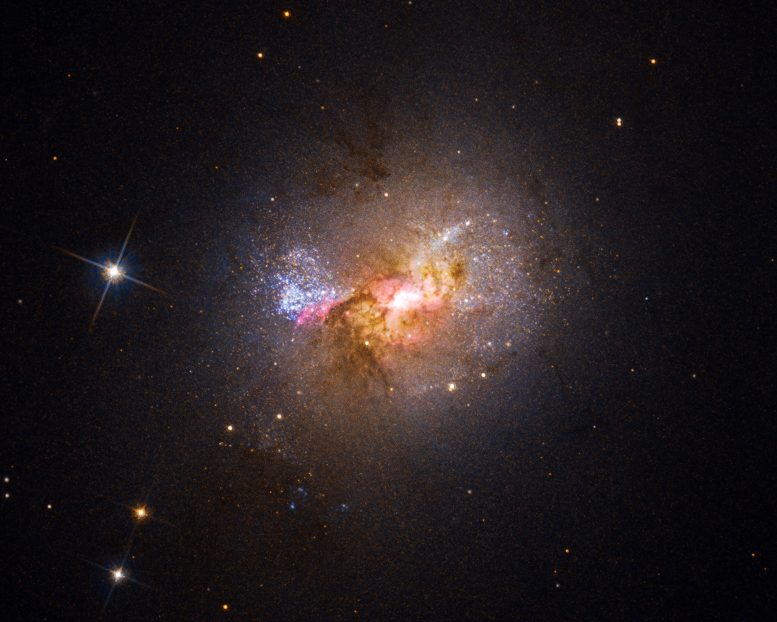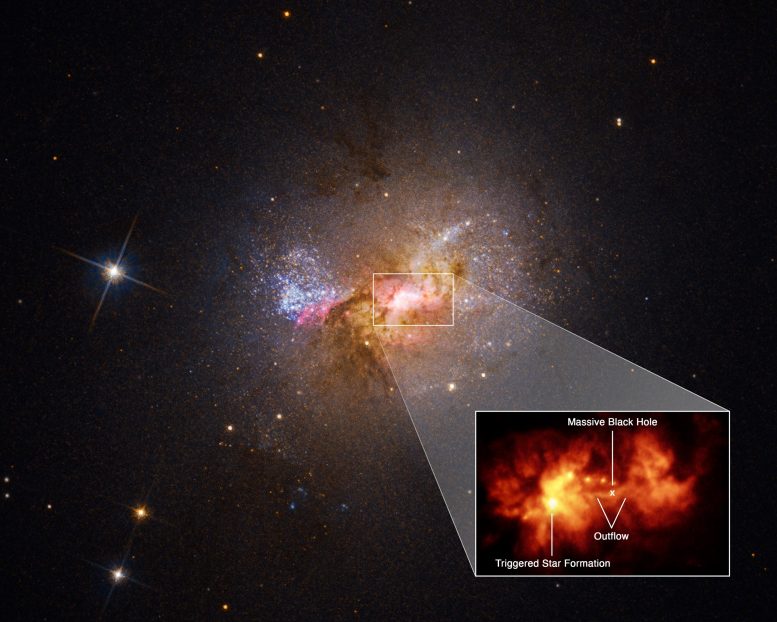
Dwarf Galaxy Henize 2–10 Continues To Make a Big Impact, Defying Astronomers’ Expectations
Recent Hubble observations reveal that the black hole in the dwarf galaxy Henize 2-10 is encouraging star formation by compressing gas through outflows. This finding contradicts the traditional view of black holes as purely destructive and may provide insights into the formation of supermassive black holes.
Black Holes As Creators: A New Perspective From Hubble
Black holes are often described as the monsters of the universe—tearing apart stars, consuming anything that comes too close, and holding light captive. Detailed evidence from NASA’s Hubble Space Telescope, however, shows a black hole in a new light: fostering, rather than suppressing, star formation. Hubble imaging and spectroscopy of the dwarf starburst galaxy Henize 2-10 clearly show a gas outflow stretching from the black hole to a bright star birth region like an umbilical cord, triggering the already dense cloud into forming clusters of stars. Astronomers have previously debated that a dwarf galaxy could have a black hole analogous to the supermassive black holes in larger galaxies. Further study of dwarf galaxies, which have remained small over cosmic time, may shed light on the question of how the first seeds of supermassive black holes formed and evolved over the history of the universe.
Hubble imaging and spectroscopy of the dwarf starburst galaxy Henize 2-10 clearly show a gas outflow stretching from the black hole to a bright star birth region like an umbilical cord, triggering the already dense cloud into forming clusters of stars. Credit: NASA’s Goddard Space Flight Center; Lead Producer: Paul Morris
Astronomical Insights From Dwarf Galaxy Henize 2-10
In the most recent study from NASA’s Hubble Space Telescope, black holes play a less villainous role than they often do as destructive monsters that imprison light. The dwarf galaxy Henize 2-10’s central black hole is not devouring stars; rather, it is producing new ones. The galaxy’s inferno of new star creation seems to be fueled in part by the black hole. The dwarf galaxy is located in the southern constellation Pyxis, 30 million light-years away.
A decade ago this small galaxy set off debate among astronomers as to whether dwarf galaxies were home to black holes proportional to the supermassive behemoths found in the hearts of larger galaxies. This new discovery has little Henize 2-10, containing only one-tenth the number of stars found in our Milky Way, poised to play a big part in solving the mystery of where supermassive black holes came from in the first place.
Groundbreaking Observations of Black Hole Dynamics
“Ten years ago, as a graduate student thinking I would spend my career on star formation, I looked at the data from Henize 2-10 and everything changed,” said Amy Reines, who published the first evidence for a black hole in the galaxy in 2011 and is the principal investigator on the new Hubble observations, published in the January 19 issue of Nature.

“From the beginning, I knew something unusual and special was happening in Henize 2-10, and now Hubble has provided a very clear picture of the connection between the black hole and a neighboring star forming region located 230 light-years from the black hole,” Reines said.
Hubble’s Discovery: Gas Outflows Spawning New Stars
That connection is an outflow of gas stretching across space like an umbilical cord to a bright stellar nursery. The region was already home to a dense cocoon of gas when the low-velocity outflow arrived. Hubble spectroscopy shows the outflow was moving about 1 million miles per hour, slamming into the dense gas like a garden hose hitting a pile of dirt and spreading out. Newborn star clusters dot the path of the outflow’s spread, their ages are also calculated by Hubble.
Contrary to what is seen in larger galaxies, when material falling toward the black hole is swept away by encircling magnetic fields, generating flaming jets of plasma flying at almost the speed of light, this process occurs in smaller galaxies. Gas clouds trapped in the path of the jets would be heated to an extreme that would prevent them from cooling and becoming stars. However, Henize 2-10’s less massive black hole and its gentler outflow caused just the right amount of gas compression to trigger the birth of new stars.
“At only 30 million light-years away, Henize 2-10 is close enough that Hubble was able to capture both images and spectroscopic evidence of a black hole outflow very clearly. The additional surprise was that, rather than suppressing star formation, the outflow was triggering the birth of new stars,” said Zachary Schutte, Reines’ graduate student and lead author of the new study.
The Potential Role of Dwarf Galaxies in Black Hole Research
Ever since her first discovery of distinctive radio and X-ray emissions in Henize 2-10, Reines has thought they likely came from a massive black hole, but not as supermassive as those seen in larger galaxies. Other astronomers, however, thought that the radiation was more likely being emitted by a supernova remnant, which would be a familiar occurrence in a galaxy that is rapidly pumping out massive stars that quickly explode.
“Hubble’s amazing resolution clearly shows a corkscrew-like pattern in the velocities of the gas, which we can fit to the model of a precessing, or wobbling, outflow from a black hole. A supernova remnant would not have that pattern, and so it is effectively our smoking-gun proof that this is a black hole,” Reines said.
Reines expects that even more research will be directed at dwarf galaxy black holes in the future, with the aim of using them as clues to the mystery of how supermassive black holes came to be in the early universe. It’s a persistent puzzle for astronomers. The relationship between the mass of the galaxy and its black hole can provide clues. The black hole in Henize 2-10 is around 1 million solar masses. In larger galaxies, black holes can be more than 1 billion times our Sun’s mass. The more massive the host galaxy, the more massive the central black hole.
Exploring Theories of Supermassive Black Hole Origins
Current theories on the origin of supermassive black holes break down into three categories: 1) they formed just like smaller stellar-mass black holes, from the implosion of stars, and somehow gathered enough material to grow supermassive, 2) special conditions in the early universe allowed for the formation of supermassive stars, which collapsed to form massive black hole “seeds” right off the bat, or 3) the seeds of future supermassive black holes were born in dense star clusters, where the cluster’s overall mass would have been enough to somehow create them from gravitational collapse.
So far, none of these black hole seeding theories has taken the lead. Dwarf galaxies like Henize 2-10 offer promising potential clues, because they have remained small over cosmic time, rather than undergoing the growth and mergers of large galaxies like the Milky Way. Astronomers think that dwarf galaxy black holes could serve as an analog for black holes in the early universe, when they were just beginning to form and grow.
“The era of the first black holes is not something that we have been able to see, so it really has become the big question: where did they come from? Dwarf galaxies may retain some memory of the black hole seeding scenario that has otherwise been lost to time and space,” Reines said.
Reference: “Black-hole-triggered star formation in the dwarf galaxy Henize 2-10” by Zachary Schutte and Amy E. Reines, 19 January 2022, Nature.
DOI: 10.1038/s41586-021-04215-6
The Hubble Space Telescope is a project of international cooperation between NASA and ESA (European Space Agency). NASA’s Goddard Space Flight Center in Greenbelt, Maryland, manages the telescope. The Space Telescope Science Institute (STScI) in Baltimore, Maryland, conducts Hubble science operations. STScI is operated for NASA by the Association of Universities for Research in Astronomy in Washington, D.C.
Never miss a breakthrough: Join the SciTechDaily newsletter.
5 Comments
Please help the residents of Indianapolis vote out of office the terrible Andre Carson
Andre Carson wants to destroy Israel. Carson must go
Sweet lets Keep Andre Carson in office so we can end Israel!!!!
If one would read the Bible they would know that Israel will never end. It will last 1000 years
past the last war between GOD and Satan. So much for the dreams of these men who want to end Israel.
Just5 because Large black holes ear aprt suns and galaxies does not ever mean there are not two sides to that black hole. One side sucks in light planets and energy, but the other end of that black hole spits out all the energy, suns and material the larger black hoe sucks in It is only a smaller black hole due to the extreme pressures and does not need to be a large black hole. Think of it as a human body. You put in a large amount of good food, the black hole uses what it needs to exit and poops out of what it doesn’t use into wherever the other end of that black hole ends. thus redistributing matter increasing and filling in area that have expanded in our universe. Th proof of my answer will become available when we have developed our technology to be able to travel from one end of a black hole to the other and see where the other end comes out and watch how the matter and energy is transported and transformed when and where it all comes out the other end. It is only known that a black hole does not instantly destroy the matter and energy one side takes in.